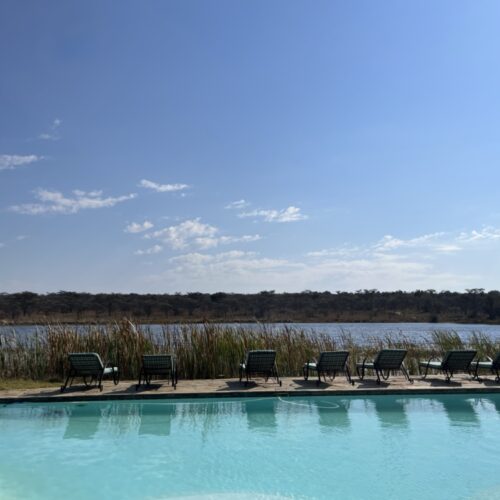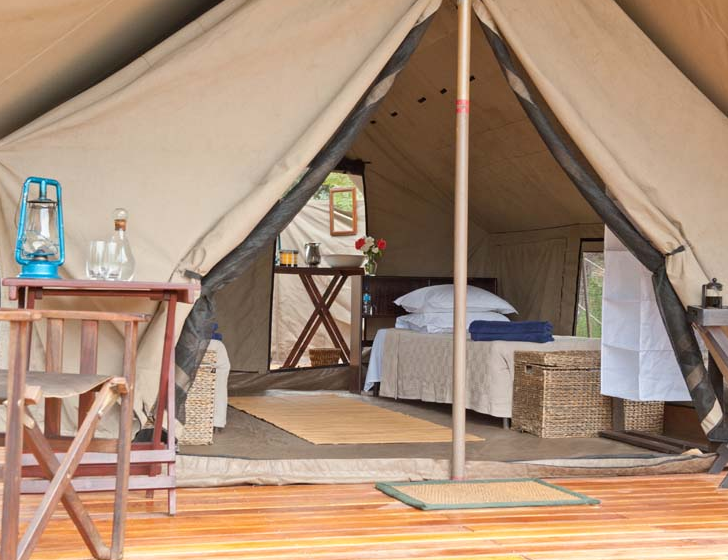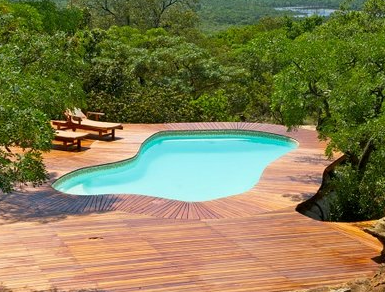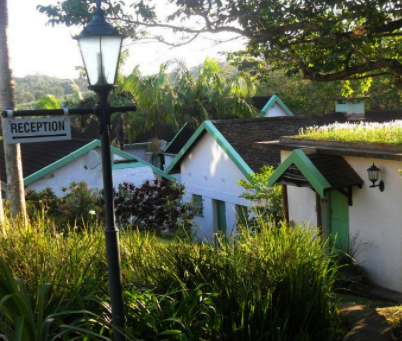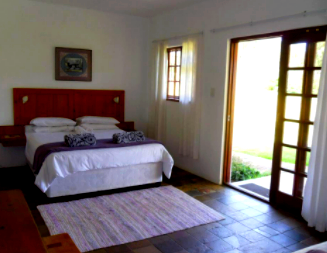-23.784560059146, 29.1460008
Horseback riding safari over eight days (seven nights): Over 150km on horseback through truly spectacular landscapes, with regular sightings of a wide range of wildlife – but also fun activities like dazzling gallops, swim with the horses, play polo-cross and jump a series of natural obstacles on the way to a spectacular sunset spot. To cover these distances and enjoy all these activities, while maintaining group cohesion, riders must be of at least an intermediate level. If the guides feel that a rider is not capable of participating in this safari, alternative rides from the lodge will be arranged. Riders typically enjoy two equestrian activities per day – usually a longer ride in the morning. And either a shorter ride or a fun horseback riding activity in the afternoon. During the safari, riders experience all parts of the 15,000-acre reserve using carefully planned routes. Given the diversity: from vast open plains to savannah, rocky outcrops, wetlands and dense forests: You are sure to encounter greater numbers of wildlife than this, the species typically seen in this veritable Noah's Ark of the Waterberg: giraffe, hippopotamus, Cape buffalo, elk, zebra, zebra, roan, kudu, impala, waterbuck, red hartebeest, nyala, tsessebe, wildebeest, blesbuck, bushbuck, ostrich, baboon, monkey vervet, warthog and jackal. We occasionally see a crocodile, a brown hyena, a serval, a duiker, a bush pig, a steenbuck and reedbuck. They are all superb animals and a privilege to observe them in their natural environment. An unforgettable horseback safari experience. which allows you to enjoy a range of accommodation types: from the well-known Horizon Lodge perched on the edge of a magnificent lake and surrounded by horses, to the canvas camp of Camp Davidson high on a secluded ridge, to the lodge chic Bellevue Plains that overlooks vast plains filled with herds of wildlife
EQUESTRIAN SAFARIS
SEE ALL OUR OFFER: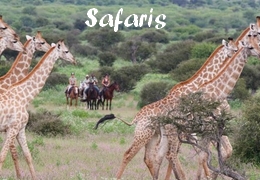
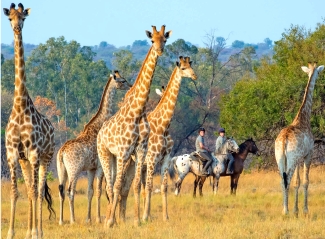
SAFARI A CHEVAL EN AFRIQUE DU SUD
PROGRAMME INDICATIF *
DAY 1 - SUNDAY: Transfer from the airport and first meetings – Introductory ride The riders are personally welcomed at the OR Tambo airport in Johannesburg. The transfer to Horizon Lodge in the Waterberg Biosphere Reserve in Limpopo Province takes approximately three hours. After a light lunch in the Lodge gardens, and later tea, the riders discover the horses. The first ride is an introduction to the reserve and an excellent opportunity for first encounters with species such as zebra, giraffe and hippopotamus. Gaits range from easy walking to galloping on sandy tracks. Sunset aperitif in the open plains. Since the first two nights of the safari are at Horizon Lodge, the center offers a herd of almost 100 horses, you have plenty of time to ensure that
the most suitable horse is available for the long days in the saddle of the last five days of safari.
 DAY 2 - MONDAY: Open plains, swimming with horses and game galore. This morning's ride is quite sporty. The route follows the center of an open valley that is home to species such as kudu, sable, reedbuck, red hartebeest, waterbuck and impala. The sandy tracks are excellent and the route crosses open meadows and winds through dense forest. Dark red cattle raised on the property are often encountered on this route. When conditions permit, the final stretch of the ride involves fast gallops along the lakefront adjacent to Horizon Lodge. It's a great experience, but don't expect to stay dry. There is also the possibility of cooling off while experiencing the exhilaration of swimming on horseback. The afternoon walk heads east following the river passing a series of dams where encounters with hippos are likely and returns across the open plains. At this time of day, there is often a lot of activity on the plains. It is a truly magical experience to be able to ride so close to these wild animals, completely relaxed in the presence of the horses.
DAY 2 - MONDAY: Open plains, swimming with horses and game galore. This morning's ride is quite sporty. The route follows the center of an open valley that is home to species such as kudu, sable, reedbuck, red hartebeest, waterbuck and impala. The sandy tracks are excellent and the route crosses open meadows and winds through dense forest. Dark red cattle raised on the property are often encountered on this route. When conditions permit, the final stretch of the ride involves fast gallops along the lakefront adjacent to Horizon Lodge. It's a great experience, but don't expect to stay dry. There is also the possibility of cooling off while experiencing the exhilaration of swimming on horseback. The afternoon walk heads east following the river passing a series of dams where encounters with hippos are likely and returns across the open plains. At this time of day, there is often a lot of activity on the plains. It is a truly magical experience to be able to ride so close to these wild animals, completely relaxed in the presence of the horses.
DAY 3 - TUESDAY: An early start is necessary for the long drive to either Savannah Lodge in the far southwest of the reserve, or Seringa Lodge in the southeast. In places the bush is thick but often the landscape opens up to grasslands with panoramic views to the south and west. Crossing this landscape gives riders a feeling of the immensity of the African plains. The area has a very high concentration of game with herds of over 300 blesbuck, or 80 elk, are often seen. Other species are often encountered, such as the red hartebeest, the tsessebe and the ostrich. There are lots of zebra, wildebeest, impala and giraffe, and smaller groups of sable, roan and waterbuck. The final stretch to Savannah Lodge is along a wooded creek where kudu and bushbuck are likely to be seen. After a moment of relaxation around the swimming pool, it is time to reach the southernmost areas of the reserve in search of Cape buffalo. They are members of Africa’s famous “Big Five” who deserve their reputation. Riders must be alert and responsive to instructions from guides. This area is known for its spectacular sunset over the distant headlands of the Waterberg Escarpment – the perfect end to an eventful and memorable day in the African wilderness.
 DAY 4 – WEDNESDAY: Return from Bellevue and “Big Five” safari Another long journey through game-rich country brings riders back to the heart of safati. The route taken is different from that of the outward journey: an exciting journey crossing diverse landscapes and different ecosystems. Game species generally prefer different habitats, with nyala and bushbuck for
DAY 4 – WEDNESDAY: Return from Bellevue and “Big Five” safari Another long journey through game-rich country brings riders back to the heart of safati. The route taken is different from that of the outward journey: an exciting journey crossing diverse landscapes and different ecosystems. Game species generally prefer different habitats, with nyala and bushbuck for
example occupying dense forest-like sections of the reserve while blesbuck and hartebeest remain in the open plains, and, unsurprisingly, waterbucks and reedbucks are normally seen near streams and other watercourses. 'water. The route offers excellent opportunities to see giraffes, which is always a highlight. After more than five hours in the saddle, the afternoon activity is an optional (not included) car safari in the surrounding area. Discovery of the Entabeni or Welgevonden animal reserves. Although it involves an hour or more of travel to reach these destinations, the opportunity to see lions, elephants and rhinos in their natural environment makes this excursion worthwhile.
 DAY 5 – THURSDAY: Bush Breakfast and Camp Davidson. This day's route goes deep into the reserve. After about three hours in the saddle, riders arrive under a giant wild fig tree for a delicious bush breakfast prepared over a fire. After this hearty meal, the route back to the lodge passes through a dense forest area. That afternoon, riders depart Horizon Lodge and head to Camp Davidson for a special night under canvas. The camp is perched on a ridge overlooking a vast wilderness area to the east. It's not a long drive, but the route is exciting, following a narrow path along the edge of the ridge. Wildlife often encountered in the area includes: baboon, bush pig, kudu and klipspringer. Porcupines are frequent nocturnal visitors to the camp and leopards outside the tents are not uncommon.
DAY 5 – THURSDAY: Bush Breakfast and Camp Davidson. This day's route goes deep into the reserve. After about three hours in the saddle, riders arrive under a giant wild fig tree for a delicious bush breakfast prepared over a fire. After this hearty meal, the route back to the lodge passes through a dense forest area. That afternoon, riders depart Horizon Lodge and head to Camp Davidson for a special night under canvas. The camp is perched on a ridge overlooking a vast wilderness area to the east. It's not a long drive, but the route is exciting, following a narrow path along the edge of the ridge. Wildlife often encountered in the area includes: baboon, bush pig, kudu and klipspringer. Porcupines are frequent nocturnal visitors to the camp and leopards outside the tents are not uncommon.
DAY 6 - FRIDAY: Sunset Lake, splashing gallop,. Today's route covers the north-eastern areas of the reserve, descending from camp until crossing a stream and open plain, then through undisturbed bushland to the headwaters of Sunset Lake. This lake is a favorite place for the reserve's hippos and is home to
crocodile, otter, fish eagle and other aquatic birds, such as the magnificent African jacana. You stay on the lookout for hippos. These animals, although they have the reputation of being among the most dangerous in Africa, are not a threat. The route offers the opportunity to do some beautiful splashing gallops. After the morning's efforts, you can relax around the swimming pool and enjoy the magnificent unspoilt setting. The afternoon activity is "polo-cross", a mix between polo and cross. The game is very addictive! Horses accustomed to the game are used and no previous experience is required. . Tonight’s dinner begins with a wine tasting.
 DAY 7 – SATURDAY: Until the sunset spot. The route follows the valley to the eastern limit of the reserve, before crossing to the
DAY 7 – SATURDAY: Until the sunset spot. The route follows the valley to the eastern limit of the reserve, before crossing to the
the highlands near Camp Davidson, then you meander along game trails to the lodge. Beautiful extended gallops, interspersed with off-piste walks with panoramic views of the Waterberg highlands. In the afternoon, riders follow a route with optional cross-country jumps on the way to the sunset in a stunning location
with views of the hills. A slow return to the Lodge at dusk ends the day's adventure.
DAY 8 – SUNDAY: Last horseback safari and transfer to the airport. Riders now know all aspects of the horseback safari experience and in consultation with their guides can suggest a preferred ride for their final experience. This is one last opportunity to ride among Africa's incredible antelope species through a magnificent environment. After lunch in the garden, it is time to head back to Johannesburg airport.
MEETING:
Sunday at 10:15 am at Johannesburg airport. Transfer by car to the base camp.
Flights must arrive before 9:00 a.m.
DEPARTURE:
SUnday. Transfer by car to Johannesburg airport (early afternoon) flights must be the evening.
TRANSFERS FROM/TO JOHANESBURG AIRPORT:
Group transfers at the fixed times: 200 € / person round trip
FLIGHTS:
Flights to/from Johannesburg are not included in our prices because it is generally more interesting to book your flights yourself, an inclusive flights package is generally more expensive with agency commissions. However, we are at your disposal to help you find the best rates or to offer you a trip including transport on request: free service.
RIDING ABILITY:
To enjoy this equestrian safari, it is essential to be comfortable at the three gates (walk / trot /canter) outdoors.
GROUPS:
Generally 8 riders, maximum of 10 riders with 2 guides to group the riders by levels.
AGE:
The usual minimum age is 16 but exceptions can be made for private groups or very competent riders. Riders under the age of 12 cannot be accepted.
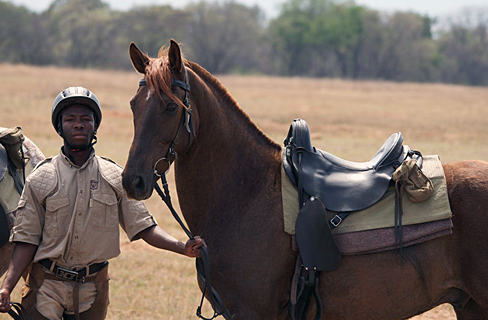 GUIDES:
GUIDES:
Local guide + English speaking support staff. The guides who run the safari have many years of experience and most of them grew up in the area and are familiar with the bush.
 HORSES:
HORSES:
A herd of about 100 horses. The herd is comprised of Boerperds, Throroughbreds, Warmbloods and Arab crosses. They range in size from 14.3hh to 17 hh. They are in excellent condition and suitable for  their job. Horses live freely in the bush.
their job. Horses live freely in the bush.
TACK:
Saddles are McClellan’s,designed for long hours of riding, they offer particular comfort and airflow for the horses back and for the rider's comfort.
HEBERGEMENT:
6 nights in South Africa.
Indicative: order and accommodation may vary depending on dates and availability.
Sunday, Monday, Wednesday, Friday, Saturday: Camp Horizon - Tuesday: Bellevue lodge - Thursday: Camp Davidson
Horizon Lodge:
Horizon Lodge has been tastefully renovated over the years while retaining all of its old-world charm. With no television or newspapers, it's the perfect place to completely escape. A colonial-style veranda overlooks the lake, providing an ideal place to relax with a drink while taking in the beautiful surroundings and enjoying the company of friends. The pier on the lake can be used as a place to sunbathe and there is also a swimming pool in the garden for you to relax.
Three main room types are available: two standard rooms, four garden chalets (the Twin Peaks rooms and the two ground floor rooms of the Hippo Suite) and three luxury chalets (Rock Lodge, Lakeside and the great room at the floor of the Hippo suite). All rooms have a private bathroom and can be booked as a twin or double. Standard rooms can only be booked for single occupancy. The garden chalets are spacious and have shared verandas. Luxury chalets offer the most privacy and have their own veranda/balcony.

Camp Davidson:
You stay in ornate canvas tents nestled among sandstone ridges overlooking grassy valleys.
The tents have sheets and duvets.
Each tent also has a private bathroom with bucket showers.
There are jugs and sinks and flush toilets. There is also a small plunge pool.
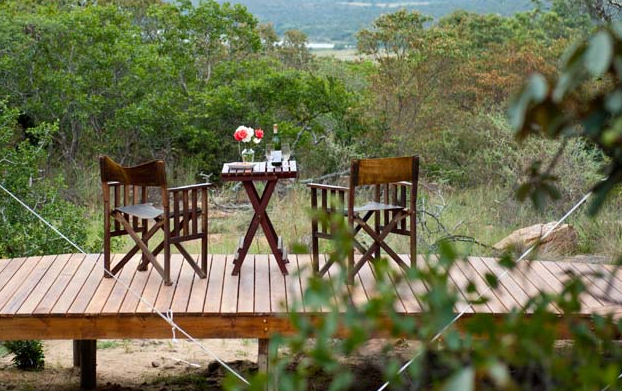
Bellevue Lodge :
This luxury lodge is less than a morning's drive from Camp Davidson. It is located on the southwest side of the reserve and is a tastefully decorated lodge with 5 en-suite bedrooms. The lodge had a large comfortable living space and indoor and outdoor dining areas.
There is a small swimming pool and terrace which overlooks a plain and a nearby waterhole, where wildlife can frequently be seen.
There is no Wi-Fi access at the lodge
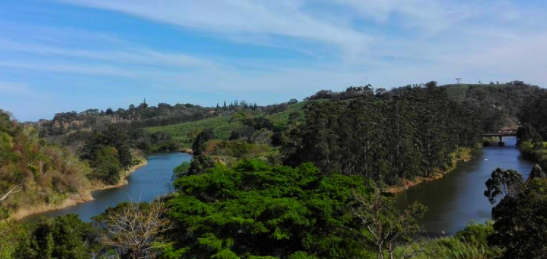
REPAS:
Taken in large tents on camps, in lodges, or at the table under the stars! The breakfasts are copious buffets: savory or sweet, hot drinks.Lunch is a buffet, usually pies, salads, fruit and desserts. Dinner is a 3-course meal served to you at the table, sometimes under the canopy of stars!The water is filtered to the strictest standards and is guaranteed to be perfectly drinkable. Drinks are included: beers, ciders, local wines and spirits such as gin.
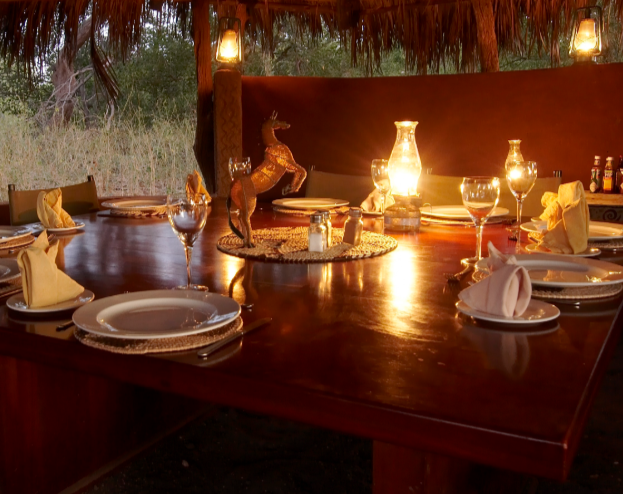

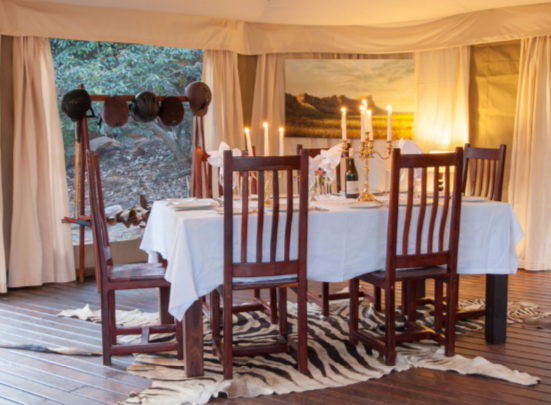
2025 PRICE / PER PERSON* :
06/01 to 01/03:
2500 € in 1-2 person garden chalet
3500 € in single de luxe chalet
02/03 to 29/06:
2700 € in 1-2 person garden chalet
3700 € in single de luxe chalet
01/07 to 04/01/2025:
3150 € in 1-2 person garden chalet
4330 € in single de luxe chalet
All dates:
Johannesburg airport transfers at fixed days & times: 200 € / person round trip.
Big Five car safari on Wednesday: ±120 € to be paid directly on site if available.
Booking fees: 15 €
* Prices may be revised downwards or upwards depending on variations in the exchange rate.
2026 PRICE / PER PERSON* :
06/01 to 01/03:
2850 € in 1-2 person garden chalet
3950 € in single de luxe chalet
02/03 to 29/06:
3050 € in 1-2 person garden chalet
4300 € in single de luxe chalet
01/07 to 04/01/2025:
3550 € in 1-2 person garden chalet
4990 € in single de luxe chalet
All dates:
Johannesburg airport transfers at fixed days & times: 200 € / person round trip.
Big Five car safari on Wednesday: ±120 € to be paid directly on site if available.
Booking fees: 15 €
* Prices may be revised downwards or upwards depending on variations in the exchange rate.
THE PRICE INCLUDES:
Rental of the equipped horse, a local guide, accommodation, meals, drinks, financial guarantee of your payments by our travel operator guarantee.
THE PRICE DOESN'T INCLUDE:
Personal insurance, personal expenses, tips, travel to and from the lodge, anything not listed in "price includes".
INSURANCE:
A civil liability and travel insurance (assistance/repatriation) is compulsory. A cancellation insurance is strongly recommended.
A payment by credit card can make you benefit from its possible insurance (check your contract).
We offer to Europe Union, Switzerland, Liechtenstein, Norway residents: the Chapka insurances.
Cap Security: full insurance with cancellation. Cap Cancellation: cancellation only.
See prices - See information
FLIGHTS:
Flights are not included because it is more interesting to book your ticket, a transport package included is sometimes more expensive with agency commissions. However, we are at your disposal to help you find the best prices (free service) or offer you a transport trip included on request.
RATES “FROM” ARE IN STANDARD BEDROOM EXCLUDING JOHANNESBURG AIRPORT TRANSFERS
IN SUPERIOR BEDROOM: ON REQUEST
THIS HORSE SAFARI CAN BE OFFERED FOR THE DURATION OF YOUR CHOICE THE FOLLOWING DATES & RATES ARE FOR 8 DAYS 7 NIGHTS
CLIMATE:
Month | Jan | Feb | Mar | Apr | May | Jun | Jul | Aug | Sep | Oct | Nov | Dec |
Average High Temperature (°F) | 84 | 84 | 82 | 79 | 75 | 70 | 70 | 75 | 80 | 82 | 83 | 84 |
Average Low Temperature (°F) | 63 | 62 | 60 | 54 | 47 | 41 | 41 | 45 | 51 | 56 | 59 | 62 |
Average High Temperature (°C) | 29 | 29 | 28 | 26 | 24 | 21 | 21 | 24 | 27 | 28 | 28 | 29 |
Average Low Temperature (°C) | 17 | 17 | 16 | 12 | 8 | 5 | 5 | 7 | 11 | 13 | 15 | 17 |
Average Precipitation (days of rain) | 10 | 8 | 8 | 6 | 1 | 0 | 0 | 0 | 1 | 6 | 10 | 11 |
SEASONS:
The climate over most of Southern Africa is temperate. Hot, dry conditions are usually encountered in the Tuli region. Heavy summer thunderstorms of short duration in the late afternoon and evening may be experienced. Rainfall occurs mostly during the summer months (October - March).
Summer (December to February):
The temperatures are high and there is a lot of humidity in the air. The chances of convectional thunderstorms are great. Some of the summer migrant birds begin to arrive. The characteristic call of the Red-chested Cuckoo rings out clearly, heralding the approach of better times for all. Once good rains have fallen, the small, drab, but extremely vocal Monotonous Lark keeps the bush awake day and night with its irritating call, as they perch on every treetop.
Kudus calve and there is a good chance of seeing late Impala lambs, tottering along on spindly, wobbling legs behind their mothers. Due to the heat, the animals wisely begin to seek shade before 8 o’clock in the morning, only becoming active again in the late afternoon, just prior to sunset. Tropical thunderstorms are a regular afternoon feature and there is a high probability of flooded rivers to add some excitement to game drives.
Autumn (March to May):
The transition from summer to winter occurs rapidly in the Limpopo Valley. Finally the searing heat of summer begins to abate and there is less likelihood of rain. This is a truly splendid time of the year. It is now Autumn and the daily temperatures are most pleasant with balmy days and nights. Temperatures begin to drop rapidly after sunset and both evening and morning game drives require warmer clothing. Although chilly in the morning, the days are clear and pleasant with crisp blue skies. Now that the rains are over, the veldt begins to dry out and game begins to congregate around the major watercourses, such as the Limpopo and associated wetlands, as well as the artificial waterholes scattered throughout the reserve.
A few late Kudu calves may make a bemused appearance in the beginning of March. Large nursery herds of gawky Impala young are found, kept under some control by the watchful eyes of their mothers.
The bush is still dense, but the bright shades of green are starting to become duller as the year progresses. As the vegetation begins to thin, the elusive leopard is more frequently seen. Lions, which dispersed with the game during the wet season, now begin to concentrate their activities in the central area of Mashatu.
Winter (June to August):
Winter is now upon us and has spread its chilly grip on Mashatu. The days are still good, with crisp mornings. The nights can be very cold.
Most of the natural pans and pools have now completely dried up. Elephant and a host of other species begin to frequent the artificial waterholes at both Main and Tent Camps, which makes for exciting mealtime viewing. Predator sightings are good at this time of the year, due to the thinned out vegetation and concentrations of game, cheetah however are scarce. In general the game is more active later into the day.
This is also a favorable time to visit the archaeological site at the Motloutse River. The summer vegetation has disappeared and a host of interesting features are now visible.
Towards the end of winter, the floodplains and grasslands adjacent to the Limpopo are very dry and barren. The bush has become harsh and almost inhospitable, with absolutely no groundcover, only dust and rocks visible for kilometers. The veldt has all the typical winter hues of brown and red, as the Mopane leaves start turning. The weather is fine with temperatures increasing slightly. The early mornings and evenings being not as cold as in June or July. August is a showy month, with respect to sunsets. Due to the very dry conditions, large quantities of dust is taken up into the air, giving rise to spectacular pyrotechnic displays as the sun sinks below the horizon.
Spring (September to November):
The bush is still very dry, a condition exacerbated by winds, which blow from August through to October. Temperatures begin to steadily increase and conditions are becoming desperate for many of the herbivores. This is due to sub region frontal systems touching on the Limpopo Valley, bringing superheated air into the region. There may be an occasional tropical thunderstorm, but this early rain is sucked up like a sponge by the barren earth. This welcome water is however not enough, and seldom results in a notable floral display. Many trees begin to blossom, in anticipation of the rapidly approaching summer. The vibrant hues of the blossoms enliven the bush, providing a bountiful treat for baboons and other hungry inhabitants of the bush, all of whom have struggled through the lean winter months. Temperatures begin to creep upwards and game drives are once again early morning and late afternoon affairs, as a wise means of avoiding the debilitating midday heat.
Predators have a field day, as many of the game are weak and tend to restrict their activities to the area close to the waterholes. The lack of dense vegetation and the dry powdery soil make tracking lion and leopard an easier task and often result in exceptional sightings. Elephant listlessly wait out the dry season, moving from waterhole to waterhole, where they take full advantage, wallowing and drinking for hours. They will feed on the surrounding vegetation, moving into the bush on feeding forays when temperatures have dropped sufficiently for them to forage out of the protective shade. It is also at this time that eland begin to calve.


